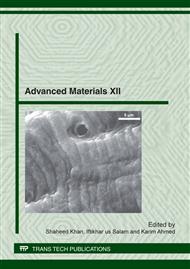p.277
p.284
p.293
p.301
p.307
p.315
p.321
p.330
p.335
Isotropic and Anisotropic Nanocrystalline NdFeB-Based Magnets Prepared by Spark Plasma Sintering and Hot Deformation
Abstract:
Isotropic and anisotropic NdFeB permanent magnets were prepared by Spark Plasma Sintering (SPS) and SPS followed hot deformation (HD), respectively, using melt spun NdFeB ribbons with various compositions as starting materials. It is found that, based on RE-rich composition, SPSed magnets sintered at low temperatures (<700 C) almost maintained the uniform fine grain structure inherited from rapid quenching. At higher temperatures, a distinct two-zone (coarse grain and fine grain zones) structure was formed in the SPSed magnets. The SPS temperature and pressure have important effects on the grain structure, which led to the variations in the magnetic properties. By employing low SPS temperature and high pressure, high-density magnets with negligible coarse grain zone and an excellent combination of magnetic properties can be obtained. For single phase NdFeB alloy, because of the deficiency of Nd-rich phases, it is relatively difficult to consolidate micro-sized melt spun powders into high density bulk magnet, but generally a larger particle size is beneficial to achieve better magnetic properties. Anisotropic magnets with a maximum energy product of ~38 MGOe were produced by the SPS+HD process. HD did not lead to obvious grain growth and the two-zone structure still existed in the hot deformed magnets. The results indicated that nanocrystalline NdFeB magnets without significant grain growth and with excellent properties could be obtained by SPS and HD processes.
Info:
Periodical:
Pages:
307-314
Citation:
Online since:
May 2012
Authors:
Price:
Сopyright:
© 2012 Trans Tech Publications Ltd. All Rights Reserved
Share:
Citation:


